Classic muscle cars were defined by their brawny V8s – it was the whole point of the thing. But it’s not necessary to buy the V8 to get brawny performance out of a modern muscle car.
If you buy a new Mustang – which is available with a 332 horsepower turbocharged four cylinder engine.
This four cylinder makes more power and performs better than classic-era Mustang V8 engines – including the 1970 Boss 302 Mustang’s V8. At the time, it was one of the highest-performance V8s you could buy.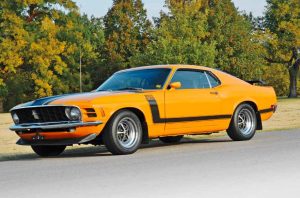
But the times have changed.
What It Is
Mustang is the Coke of cars – everyone knows what it is, even if they aren’t car people.
Ford has been building them continuously and successfully since 1964 – making it the only muscle car to have survived not only the muscle car era of the ’60s but also the Disco era of the ’70s, the Reagan era of the ’80s and the Ricer era of the ’90s and still be alive and kicking today.
Its primary rivals – the Dodge Challenger and Chevy Camaro – both got cancelled and had to be resurrected. Neither was able to maintain the intergenerational following the Mustang has sustained since its inception. 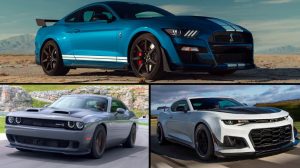
Prices start at $26,670 for a base coupe with the 2.3 liter turbocharged four cylinder engine and a six-speed manual transmission.
The V8 GT – with 460 horsepower – starts at $35,630.
A top-of-the-line Bullitt GT – named after the famous car-chase movie featuring Steve McQueen – stickers for $47,180.
It comes with an even more powerful version of the GT’s V8.
There’s also an ultra-performance GT500 Mustang – which will be reviewed separately.
A High Performance Package for Mustangs without the V8 is now available.
It boosts the power of the 2.3 liter engine to 332 horsepower (310 is standard) and includes a heavy-duty Torsen limited slip rear axle with 3.55 ring and pinion, heavy-duty cooling, machine-faced 19-inch wheels and 40-series ultra-performance tires, upgraded brakes and suspension, “active” exhaust baffling, additional gauges and numerous interior and exterior styling upgrades.
It’s basically a GT – for a lot less.
Four cylinder Mustang outperforms every classic-era V8 powered Mustang – and many more recent-era Mustangs, too.
V8 is still available – for even more performance.
Usable back seats; surprisingly roomy trunk.
What’s Not So Good
Center console storage cubby is tiny and hard to access because it’s set back too far in relation to the driver.
Under The Hood
The Mustang’s standard 2.3 liter turbocharged four cylinder engine makes an impressive 310 horsepower. Impressive – because it’s more power than a ’70 Boss 302’s 5.0 liter V8 made (290 hp) even when you “spot” the old Boss the unrealistic SAE gross horsepower measuring method that was in use when it was new. 
If the ’70 Boss 302’s output were measured using today’s SAE net method – an off-the-line production engine (not a specially tuned ringer engine) installed in the car with all accessories attached and a full production exhaust system – as opposed to the ringer engine on a stand, with open headers and no accessories to sap its power – the ’70 302’s rated output would probably be around 250, net.
But even when compared with a modern V8 performance engine rated using the more realistic SAE net standard, the 2.3 liter four’s output is stupendous. A ’95 Cobra R’s 5.8 liter 351 V8 which was almost three times the size only made 300 hp, net.
And the ’95 Cobra R was a race car with a fuel cell – and without power anything – that Ford didn’t sell to the general public.
It didn’t have AC, a radio – or even back seats. Your had to have an SCCA road racing license and know someone inside Ford to get your mitts on one.
And it was slower than a base 2020 Mustang with climate control AC, a stereo, power everything and back seats – that anyone can buy.
With the new Performance Package, the 2.3 liter engine’s output rises to 332 hp. It is almost unbelievable. Consider it on a power-per-liter basis. If the 2.3 liter engine were a 4.6 liter V8, it’d be making 664 horsepower.
Yes, we live in good times – despite all the bad things. 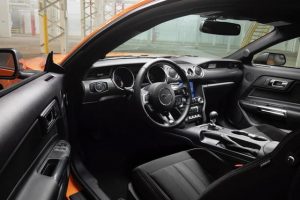
You’re also getting more horsepower than the Camaro’s standard and much less stupendous 2.0 liter four offers – which is just 275 hp – and while the Camaro’s optional 3.6 liter V6 offers slightly more horsepower (335) it offers a higher price and much less torque – only 284 ft.-lbs. vs. the turbo’d Mustang’s 350 ft.-lbs.
Which explains why the four cylinder Mustang is quicker than the not-cheaper V6 Camaro.
And much quicker than the also not cheaper V6 Challenger – which only has 305 horsepower (and just 268 ft.-lbs. of torque) to leverage much more weight (almost 4,000 lbs.) than either the Camaro or Mustang’s mills have to deal with.
It’s also the only one of the three that comes only with an automatic.
It is, however, the only one of the three that’s available with all-wheel-drive – though an automatic-and-AWD-only muscle car is as strange a beast as a flightless bird.
If 332 hp isn’t enough, the GT offers 460 horsepower out of 5.0 liters – 480 in the Bullitt GT. This edges out the Camaro SS’s standard 6.2 liter, 455 horsepower V8 and the Challenger’s standard 5.7 liter, 375 hp V8.
As with the turbo four, the V8 can be paired with a ten-speed automatic in lieu of the standard six-speed manual transmission.
On The Road
Even without the performance package, the standard, as-it-comes turbo four Mustang gets to 60 in the high fours – a time any classic-era V8 muscle car (and the ‘90s-era Mustang Cobra R) would have been envious of.
Just for reference – and to dispel the fumes of nostalgia for the Good Old Days – a ’70 Boss 302 Mustang did the 0-60 run in . . . 6.5 seconds.
With the upgrades, the four cylinder Mustang can get to 60 in the mid– fours.
That is almost as quick, seat-of-the-pants-wise, as the V8-powered GT.
But the 2.3 liter Mustang does quick more affordably.
What you’re getting here, by the way, is basically the old Focus RS in a much more appealing rear-drive layout. Quicker, too – because the rear-drive layout is better for hooking up all that power. More appealing because – well, look at it. The Focus wasn’t an ugly car but it was fundamentally an economy car.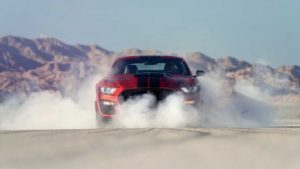
The Mustang is a Mustang.
Also, burnouts are much more fun.
The V8 GT is almost too much. It is ridiculously powerful. If you could teleport one back to 1970, it would humiliate every Ferrari – and make every muscle car seem pathetic. Today, it makes almost any six-figure exotic look like a a waste of money.
As recently as the ’90s, exotic money got you exotic performance. Something no else had who didn’t have the coin. That ’95 Cobra R – I was lucky enough to get one to play with for a week and remember it like yesterday – was exotic . . . in relation to what was generally available. Today, that R is merely collectible – a cool relic of a slower time.
Considering the new GT, I considered it in relation to the BMW 850i I test drove recently. Both similarly laid out (two doors, four seats and about the same overall size) with mighty V8s under their hoods and staggering performance capabilities. But the GT costs about a third what the BMW does. You could buy two of them – add superchargers to them to create your own home-brew GT500 – and still have enough money left over to cover gas and insurance bills for the next ten years.
It’s true the 850i is slightly quicker. And it handles a bit better – in theory. But in reality, the truth is that either car has capabilities higher than the abilities of any driver who isn’t a race car driver – or at the level of one. The difference in capabilities is also so splitting-hairs fractional that the only way to tell the difference is by instruments. Could you tell the difference, seat-of-the-pants, between 0-60 in 3.8 seconds vs. 3.6?
If you said yes, I say bullshit.
The BMW is a magnificent car and a stunning performer. But so is the Mustang. It even offers an electro-magnetic automatically self-adjusting suspension system (MagnaRide – available with either the four or the eight) that lets this car handle washed-out (and washboarded) gravel roads better than most SUVs and ride as comfortably as that six-figure BMW.
Seriously.
The main thing you’re getting, then, when you buy the BMW or some other six-figure exotic is exclusivity.
Not that there’s anything wrong with – as Seinfeld used to say.
At The Curb
One of the Mustang’s appeals is its recognizability. Everyone knows what it is – and most people like it. It transcends ages – and the sexes. It’s as beloved by people who like sporty cars as it is by people who like ferocious cars.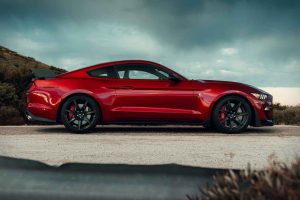
It succeeds by alienating almost no one.
This is important – if you want to stay in business. The Camaro – for all its merits as a performance car – is an alienating car. It appeals to young guys and older guys who want to feel like young guys again and to almost no one else. Most women – of all ages – hate it.
Which makes it harder for men to buy it. Which means it’s got a limited buyer base. Which means it will probably get cancelled . . . again.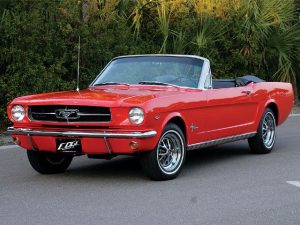
The Chevy is also a much less practical car than the Mustang – which has a people-feasible back seat with 29 inches of legroom and a trunk with almost as much room – 13.5 cubic feet – as a mid-sized sedan. The Camaro his becoming an almost-Corvette, without the cachet. It has vestigial back seats that are functionally useless for passenger carrying (24 inches of legroom and practically no headroom) and a purse-sized (9.1 cubic foot) trunk that’s got less room for carrying cargo than some motorcycles have.
The Challenger is more practical than either the Mustang or the Camaro – because it’s a much larger car. It has 33.1 inches of backseat legroom and a 16.2 cubic foot trunk – more trunk than many full-size sedans.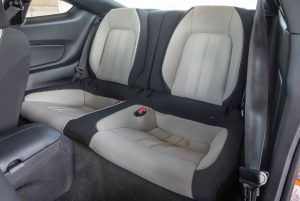
But the Challenger is almost a foot longer than the Mustang (197.9 inches vs. 188.5) and several hundred pounds heavier. It is a wonderful – but hulking and brutish – car that (like Camaro) is polarizing; it mainly appeals to men who don’t need to kowtow to the women in their lives.
Inside the Mustang, you’ll find a melding of retro-themed styling elements such as ’60s style fonts for the speedometer and the iconic galloping pony logo, which is also projected holographically underneath the open doors at night – along with modern tech, including selectable driving modes, LED mood lighting and Ford’s PassConnect suite of apps (keyless/remote start, 4G WiFi and smartphone access to various functions).
You can replace the standard gauge cluster with a configurable LCD digital gauge cluster that changes with the drive modes. In Track mode, the speedo – which you don’t need to worry about it you’re on the track – is replaced by a huge tachometer spread along the entirety of the display’s outer perimeter – so you can see at a glance where you are in the powerband.
An active exhaust system can be specified as well. What this means is basically a wastegate in the piping that bypasses the muffler when . . . activated. This reduces backpressure and amps up the sound.
You can also get – and I recommend – the available Bang & Olufsen 12-speaker surround sound audio system.
It may no make as sweet a sound as the ’95 R’s 351 V8 did (I can still hear the the reverb off the tiled walls of the Baltimore Harbo Tunnel at 130 MPH at 2:20 in the morning, on my way to New York to visit a girl I used to know) but it’s close – and you can listen to other sweet-sounds, too.
The Rest
There are two other things to love about the Mustang that have nothing to do with its power or its looks.
It doesn’t have ASS – Automated Stop/Start. Not yet. The current Mustang dates back to the pre-ASS era of about five years ago, so it’s one of the very few 2020 models you an buy without it.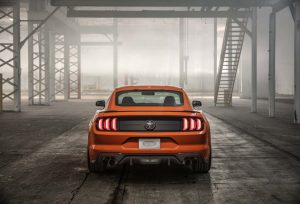
And it comes standard with a pull-up lever emergency brake – not a push-button parking brake.
One more thing. In addition to costing less to buy – and feed – than the V8 GT, the 2.3 liter Mustang should also cost less to cover – a big consideration for the younger buyers who are the Mustang’s target audience.
The Bottom Line
If you haven’t driven a four lately, maybe you should!
. . .
Got a question about cars, Libertarian politics – or anything else? Click on the “ask Eric” link and send ’em in!
If you like what you’ve found here please consider supporting EPautos.
We depend on you to keep the wheels turning!
Our donate button is here.
If you prefer not to use PayPal, our mailing address is:
EPautos
721 Hummingbird Lane SE
Copper Hill, VA 24079
PS: Get an EPautos magnet (pictured below) in return for a $20 or more one-time donation or a $10 or more monthly recurring donation. (Please be sure to tell us you want a sticker – and also, provide an address, so we know where to mail the thing!)
My latest eBook is also available for your favorite price – free! Click here. 


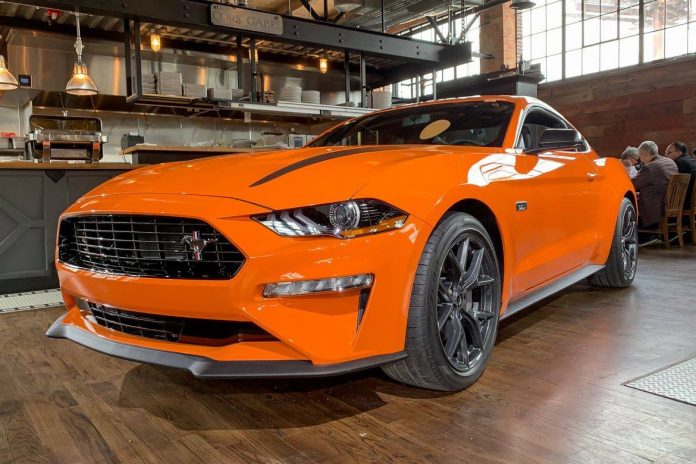











The Camaro’s problem is very simple: you can’t see out of it. People aren’t gonna buy a car they can’t see out of.
Before they reworked their site, Car and Driver had a very interesting thing in their buyers guide feature that showed total visibility from the drivers seat. The Mustang and Challenger had 120 and 123 total degrees of visibility (I will confess I do not recall which car had which number). The Camaro…had 77 total degrees of visibility; the rear window was essentially useless. That spoke volumes.
I’ve also driven all; three cars for work (I work at a shop) and I can confirm that all the jokes about not being able to see out of it are rooted in reality. It’s a shame, since it’s capable of embarrassing a lot of more expensive cars, depending on options and has one of GM’s best platforms (and I say that as someone who is a Mustang fan).
Rented one this weekend. Maybe its 2018. its a good car. Rock solid build quality. Its fast yeah but not in a fun V8 way. . Drove the turbo version. Good handling. However….its just bloated. its like a giant bumper car with poor visibility. Like youre sitting in a bathtub. All this drive by wire stuff kills the natural mechanical feel you have with an older car with a manual. i’m sure i would be safer in a crash with this thing. however i suppose i would be safer never leaving home as well. is that what we want,
When younger and had the need for speed, hopping up the engine was most of the fun,,, and you learned a lot. Now they come with everything done. No more dreams of having the fastest because today it’s all done for you…. no hopping up and no learning. Just hop in and go. But when it breaks,,, Stand by and have a high credit line.
Naaaa,,, I’m glad I lived through the low tech era. I made it go fast and when it broke,,, I fixed it. It was really fun. It made one think. Today, there’s an app for that.
Amen, Ken – that’s it, exactly!
New cars are so fast they’re not much fun. Everyone has a fast car, first of all. A Camry is faster than almost every stock ’60s and ’70s muscle car. Speed is no longer anything special, really.
The sad thing though is that with all that performance seeing how many people drive their car convinced it has the performance of a Yugo or semi, including swinging to the right to make a left hand turn.
Makes me miss my old girl, she was a good car, though Trucks what I need atm and still have the Audi
Good read though, definitely looking to eventually get another Mustang down the line (V8 Manual this time, learned my lesson let my dad help me with the down payment), and this only makes me want one sooner.
So when are you getting to the Wrangler?
Hi Zane,
Thanks!
They’re supposed to be sending me a Gladiator soon…
Can’t wait!
Shame they got ASS and stuff, love how look and how you can go topless/doorless with it.
Now I’m gonna keep an eye out for it
Just drove a ’20 base GT tonight, manual.
After taking a 25 min test drive, im sold, though my gf and sales manager are telling me to get the new Bronco
Still, after driving that, I got no doubts what I’d get otherwise, it was amazing
Zane!
No Bronco… no! Please! Get the Mustang. Do it now.
My birthday’s is December 12th, gonna order a 5.0 Vert as a 32nd present for myself (Manual of course, had so much fun between listening to the exhaust and the gearbox)
Besides that, polled 12 people i know and with you, its 8/4 Mustang anyway. Now all I need to do besides save up is think of a nickname and stockpile the parts.
Thanks for validating it btw, Eric
My wife bought a 2016 with the turbo 4. She looked at the V8, but decided on the 4 because while the V8 is amazing for going fast in a straight line, the turbo 4 is almost as fun going straight, and is actually more fun in the curves because it has better weight balance, almost 50/50, because the front end is a couple hundred pounds lighter due to the smaller engine. And given the current omnipresent police state, you’re going to be able to enjoy the curves a lot more often than the straightaways.
I like the turbo 4 but would still choose the v8. Especially because of turbo reliability. Depreciation is such on the mustangs that a used gt is about the price of a turbo 4.
Love the evolution of the Mustang. Well done Ford. And also for going to RWD on the Explorer!
So if my current fav., charger/300 v8 rwd goes away, I think this Mustang might be the only way forward. Wish they would make a sedan version. There were a few rumors of such.
Eric, you mentioned ride, but can you elaborate? I guess I would just drive one anyway though.
Hi Eric,
So how much HP do you need before you need AWD just to get enough traction to hook it all up? And an automatic just to shift fast enough in the couple of seconds before you hit 60 or 80 MPH?
700 or 800 HP? Or less?
From the Mopar camp, the same situation regarding engine displacement existed in the 1960s and 1970s. 340 Darts and Dusters could walk all over 383 and 440 versions as the “big block” versions could not adequately transmit “the power to the ground”. It was all about “balance”…
That being said, I would still want a V8 in a Mustang.
Just from the “old school”, that’s all…
There are a couple of interesting Mustangs near me. One is a 2008 Bullitt edition (the owner practically dailies this one), and a Shelby GT500RR, which is a Ford GT500R that has been “Shelby-ized” with more power and a wing + aero kit (which doesn’t look obnoxious).
The only time I’ve seen the GT500RR is in the rain, which says to me that the owner likes to live dangerously.
Considered objectively, that 4 banger is quite a car.
But if I were buying a 2020 Mustang….I gotta go V-8!
Those 4 cyl numbers are pretty amazing. What’s the thing rev to? 100,000 RPM? The tolerances on the bore must be like gauge blocks!
IIRC the high output 2.3L revs to 7k or so. Not that high in the grand scheme of things, espeically since the 5.0 redlines at 7500 RPM.
We had a 2002 GT stick convertible. Fun car.
Then we got a 2013 GT stick convertible. More gadgets…more funner….and wicked fast compared to the ’02.
Being north of 70 years old, melanoma and legs that don’t exactly work like a youngsters anymore, caused us to “downgrade” to a 2019 GT coupe with the 10 speed auto. More gadgets….even more funner…and even more wicked speed.
We don’t need this stuff, but just like an AR15, come and take it.
Hi Aljer,
I drove the new Mustang and then my TA. It was like in the Battlestar Galactica TV series. My car being the obsolete analog “Galactica” of the road vs. the new digital/AI fleet battlestars that can do so many things the ancient ship can’t… except survive the Cylons’ computer virus assault.
In 20 years, motor gods willing, the TA will still be rumbling along (and pushing 70) while these new Mustangs (and all new cars) will have gone the way of the cell phones we all threw away three years ago.